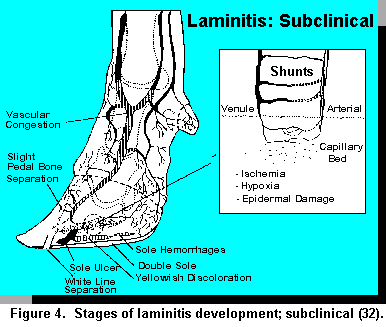Training of animals to accept close handling and a strict definition for the positive classification of laminitis was used to detect clinical cases which could have been overlooked in a field situation.
Bovine laminitis definition.
Bovine laminitis and lameness.
The link between nutrition acidosis and laminitis is the association with nutritional effects on causing metabolic acidosis decreased rumen ph and altered hemodynamics of the peripheral microvasculature resulting in hoof deterioration.
Laminitis has been described in many species but is most common in equine and bovine.
A major difference between the two species is anatomic in that the lamellar laminar surface of the equine hoof is considerably more extensive than that of the cow.
Antihistamines may be useful e g.
Nsaid non steroidal anti inflammatory drug injectable ketoprofen 2 to 4 mg kg im iv.
Correct grain overload keeping the animal moving and the claws cool.
Laminitis and lameness are the most significant diseases afflicting cattle.
The greeks aristotle associated equine laminitis with indigestion.
Laminitis is a disease that affects the feet of ungulates and is found mostly in horses and cattle.
Laminitis has been described in many species but is most common in the equine and bovine.
The model offers a new method that could be used in further investigation of the pathogenesis and pathophysiology of bovine laminitis.
A hands on approach provides veterinarians researchers and cattle producers with an invaluable and handy resource for managing these problems.
Although bovine laminitis is most common in dairy cows it has been reported in all ages and sexes.
The disease is a result of multifactorial aetiology most of which is not clearly understood.
Feeding readily fermentable carbohydrates to unaccustomed cattle predisposes to the disease.
Equine and bovine laminitis are distinctly different.
The greek name of the disease kritiasis relates to overfeeding of barley.
Bovine laminitis is also referred to as diffuse aseptic pododermatitis which results in local and systemic clinical signs 32.
Laminitis is an inflammation of the laminar corium of the hoof wall and also includes the sole corium in the bovine definition.
Clinical signs include foot tenderness progressing to inability to walk increased digital pulses and increased temperature in the hooves.
It is characterized by claw pain and lameness 33.
Although acute laminitis occurs in both species and can be caused by grain overload other etiologies can affect the equine laminae.
Injectable diphenhydramine 0 5 to 1 0 mg kg iv im.

























